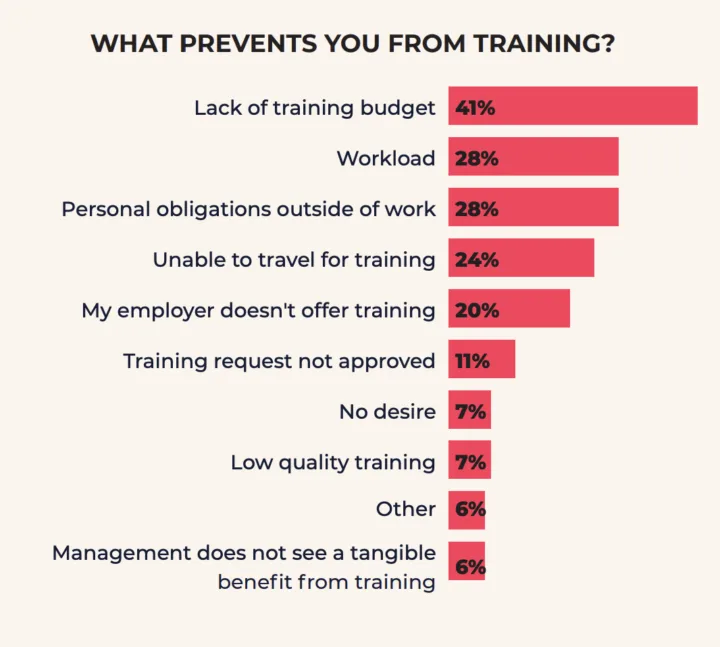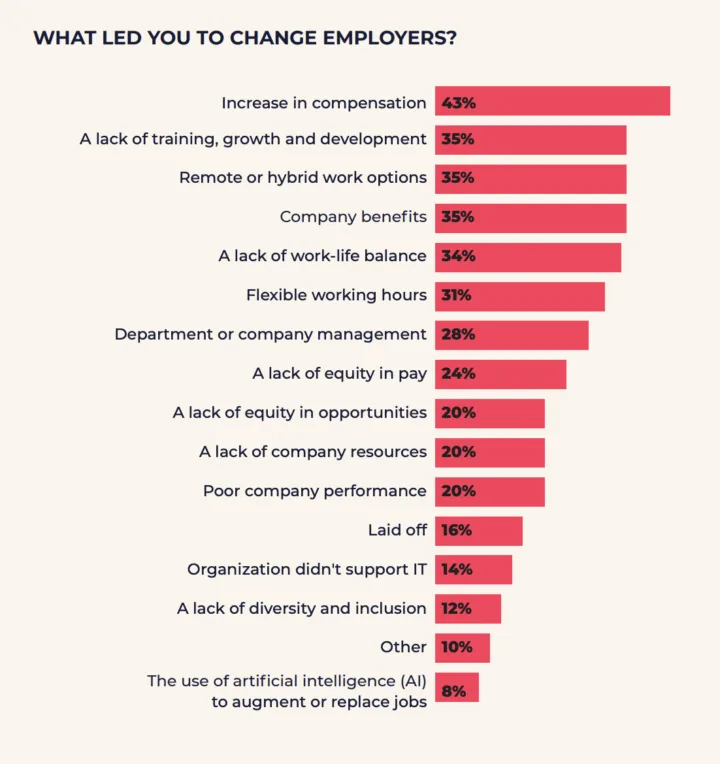
The Top 10 Challenges IT Teams Face This Year
There’s a continued strain on tech professionals across the industry, with workload emerging as the number one challenge for IT professionals.
Skillsoft’s annual IT Skills and Salary Report reveals that mounting responsibilities are leaving many feeling overwhelmed and concerned about the long-term sustainability of their roles.
Employers continue to set high expectations while limiting the resources available, creating a troubling imbalance that impacts both performance and morale. Workload and resource constraints mixed with other key challenges creates a vicious cycle in this industry that can lead to higher stress, burnout, and, ultimately, turnover.
Thousands of professionals who participated in Skillsoft’s survey offered insight into their most pressing workplace challenges.
| 1. | Workload |
| 2. | Resource and budget constraints |
| 3. | Skill gaps |
| 4. | Unclear job roles and responsibilities |
| 5. | Lack of training or professional development |
| 6. | A lack of effective leadership |
| 7. | Employee morale |
| 8. | Team or communication |
| 9. | Talent retention |
| 10. | Lack of equity in pay |
The Challenges Many Face Working In Tech
While not an exhaustive list, these 10 issues are the most common that professionals face in their day-to-day jobs. Thankfully, remedies exist for each. Read on to learn about the most common challenges and how to avoid or alleviate them.
1. Workload
Workload has emerged as the number one challenge for IT professionals this year, surpassing last year’s top issue of resource and budget constraints.
Today, nearly every company relies on technology, whether through mobile devices or impressive new AI models, driving up demand for the skills tech professionals bring to the table.
Said differently, they have their work cut out for them. Workload remains a leading barrier to training, exacerbating issues like skill gaps and employee turnover. Whenever an employee quits, it can cause disruption and increase the work for others. Further, skill gaps often lead to a decreased ability to meet business objectives and cause stress. If left unchecked, morale can erode and attrition can increase.
This is where effective leadership, coaching, and project management can make a significant impact.
This year’s findings emphasize how critical it is to get excessive workloads under control. As leaders, check in with your team to have open, honest conversations about workloads, projects, and opportunities to go beyond surviving the day to day. A disciplined approach to project management may be the ticket to quelling a never-ending stream of requests, tickets, bugs, and more.
2. Resource and Budget Constraints
Budgets are affected by many factors, internal and external. And when the budget takes a hit, it has downstream consequences for teams — many seen later on this list — like an inability to recruit teammates, pay for training, and more.
Last year, resource and budget constraints topped the list of challenges for individual contributors and team leaders, but this year it's taken the second spot under workload.
Compared to last year, more IT leaders say their budgets will remain the same in the coming year (42%). Likewise, fewer report an expected increase (44%), according to the survey. Gartner predicts IT budgets to increase roughly 9% over last year, totally $5.74 trillion.
Teams facing stagnant or reduced budgets are likely to encounter hurdles in the coming year, as heavy workloads strain their capacity and make it harder to bring in new talent.
While operating with reduced budgets or constrained resources is undoubtedly tough, it also forces creativity or inventive thinking. How can you do more (or even the same) with less? It forces efficient, focused thinking about projects, processes and the like that may need to cease or change to allow teams to carry out their best work.
It’s worthwhile to discuss this as a team and determine what the best possible outcomes may look like under strained conditions. And then, carefully plan how to make the most of the situation. Doing so creates a narrow focus on what’s most important and brings the team together to clarify priorities. This can help avoid confusion, reduce workload, and maintain high-quality outcomes.

3. Skill Gaps
Skill gaps remain a pressing issue in tech, with 19% of decision-makers reporting a high risk of unmet objectives due to these challenges. Hiring skilled professionals continues to be a major hurdle, exacerbating the situation.
This year, 65% of IT leaders report that skill gaps are present on their teams, making upskilling, and reskilling their current workforce priorities. This issue is made even worse for 34% of decision-makers who say their organizations haven’t invested enough in training.
The impacts of skills gaps can lead to revenue losses, increased security risks, and more. All of these consequences carry a price tag — some greater than others. To mitigate these effects, IT leaders plan to train their existing staff to close gaps.
Thankfully, many organizations are turning inward to address these challenges.
For those organizations that have under-funded training and remain burdened by skill gaps, it’s imperative to change course.
An investment in training produces outcomes that go far beyond earning a certification or adding skills to a resume. Training at scale can give organizations a competitive advantage, helping them build trust with existing and prospective customers. It also fosters a more engaged and loyal workforce.
Said differently, an investment in training is — according to the testimony of 5,100 IT professionals — a cure for many of the ailments seen on this list.

Read next: C-Level Tech Leaders Feel the Weight of Skill Gaps, Research Shows
4. Unclear Job Roles and Responsibilities
When change happens at work — and in tech, there is always change — it can set some on edge. If leadership isn’t transparent, people are left out of conversations, or the vision for the future is unclear, morale can take a dive and tensions can rise.
In many ways, this comes back, again, to effective leaders.
It’s a must for team leaders to make time with their staff — together and individually — to check in, talk through the changes that will impact them or the team even if all the information isn’t there.
The majority of IT staff identify team communication as the most crucial skill for IT leaders, followed by problem-solving and critical thinking. Clear, honest communication can help quell fears that stem from speculation or rumor.
Furthermore, many work in a hybrid workplace — especially those at large companies or organizations. Chances are, you’re working with other professionals outside of your timezone. If that’s true, managers must be diligent and thoughtful about how they communicate change to their teams.
If that’s difficult to do, it’s worth it to practice what you’ll say before saying it. And to schedule devoted time to get everyone on the same page.
Skillsoft’s CAISY is an AI simulator. Think of it like a coach that works with you on specific scenarios, like delivering bad news or dealing with angry customers. CAISY will imitate another and you’ll have a conversation. At the end, you’re graded and given pointers on how to improve.
If change is brewing at your job, consider working with CAISY.
Read next: The Reason Why Undefined Jobs Disrupt Role-Based Learning
5. Lack of Training or Professional Development
Mentioned above, balancing the demands of the job with the desire (and need!) to learn new skills isn’t easy. Professionals need the time and space to complete training and know that it’s okay to do.
The top three biggest hurdles for IT professionals who wish for more training opportunities are as follows:
- A lack of training budget
- Workload
- Personal obligations outside of work
Tech workers are an ambitious group. They want to learn. They want to advance their careers. They want to apply their skills to complex problems. And they will, with or without their current employer.

A lack of employee development opportunities is a make-or-break benefit for IT professionals. In fact, it’s the second most common reason why professionals decide to change employers. And almost half say professional development and training opportunities are an “extremely important” organizational benefit. According to SHRM, most workers (68%) say they would remain loyal to their employers and stay with them long-term if given training opportunities.
While budgets may be leaner, an investment in training can help fix many of the challenges on this list. And not all training requires an additional expense. If training is already available through your employer, the investment isn’t with money but time.
That’s where managers can encourage and allot time for employees to learn. Some technical teams at Skillsoft have a dedicated hour each week to learning something new. Read about it here.
6. A Lack of Effective Leadership
It’s hard to overstate the importance of effective leadership. Good, stable and effective leaders can make or break a team.
When leaders lack the skills to grow and nurture their teams, it can cause mutinous friction that leads to disjointed workflows, poor relationships, and attrition. Over one-quarter of IT professionals quit their jobs because of management.
But what are the most important skills for those in IT leadership?
Team communication is the single most important skill for IT leaders, according to 74% of survey respondents. Problem solving (70%), critical thinking (70%), interpersonal communication (66%), technical skills (62%), and project management (60%) follow.
Team communication can help clear up issues of misaligned expectations (read number four on this list), department priorities and challenges, and more.
“Leadership skills are essential to understanding and delivering business outcomes,” writes Orla Daly, CIO at Skillsoft. “Whether that’s the skills to understand and appreciate the business challenge, decipher which areas are most important to focus on, or identify and deliver the best solutions, it all requires the ability to communicate effectively, prioritize and influence, while being resilient and adaptive to change.”
Orla goes into greater detail about the importance of leadership skills in IT. See Skillsoft’s Lean Into Learning Report on page 5 to read it in full.
7. Employee Morale
Developing stronger teams is a leading challenge for nearly one-quarter of IT decision-makers as they try to fortify their departments with the capabilities to transform their organizations. In doing so, employee morale must be a part of the effort.

If feelings of apathy or dissatisfaction set in, it becomes harder to rally the team around strategic initiatives or even inspire workers to continue trudging through the daily grind.
For those in leadership, you must work within your means. Naturally, you can’t always give out promotions and raises to increase employee morale. But even smaller, sometimes overlooked steps like these can help:
- Recognize your employees’ efforts and praise their work.
- Validate their contributions, suggestions and opinions.
- Grant them more opportunities to work on skills that matter to them.
- Encourage them to pursue a new certification. (48% of IT professionals say they felt more engaged at work after earning a certification.)
- Work on the team culture by listening, gathering feedback, and enacting change when it makes sense to.
Read next: What Do Great Leaders Have in Common, and How Do You Nurture More of Them?
8. Team or Communication
While technical skills remain in demand, human skills have an elevated importance in today’s workplace. Transferable skills like these make a big impact in team dynamics, especially when bringing together cross-functional teams.
While effective communication can help solve the big, complex problems facing IT departments today, poor communication can have the opposite effect.
Evidently, many recognize this. And the result are some of the challenges on this list: unclear job roles or responsibilities, workload, effective leadership.
Without clear communication, these challenges only get worse. Everyone on the team must communicate with one another to remain clear on the priorities and the division of labor.
Solving this can take many forms. Of course, training can help. It could be using Skillsoft’s AI simulator to mimic a conversation. It could be an on-demand course or even in a peer group. And then there’s the practice of keeping records, speaking out on team calls, leading conversations and presenting to others.
Naturally, public speaking can be daunting. But not all communication must resemble a formal presentation. Keeping up notes in project management systems, posing questions during team calls, or even calling teammates briefly can go a long way. Especially in times of uncertainty or frustration, it’s worth over-communicating to prevent things from falling apart.
In business, working cross-functionally becomes paramount in completing large projects and reaching goals that carry far-reaching impacts for the organization, like transformation and growth.
9. Talent Retention
Sixty-one percent of IT professionals said they were either somewhat likely or extremely likely to look for a new job in the year ahead. That’s in spite of the many feeling satisfied with their current position. Forty-three percent reported feeling somewhat satisfied. Twenty-seven said they were extremely satisfied. Three-quarters feel they have good job security.
So why leave?
The most common answer: to get a raise.
According to research by Dice, almost two-thirds of tech workers feel underpaid. Dice’s research shows this is a growing trend. “Dating back to 2021, the amount of tech professionals feeling underpaid has steadily grown each year,” the report says.
But, pay wasn’t the only reason for moving on.
A lack of professional development opportunities has consistently ranked among the top reasons why workers choose to leave. This year, remote/hybrid work options rounded out the top three — an interesting development amid return-to-office mandates — along with company benefits and work-life balance.

As mentioned elsewhere, tech workers are hungry to learn new skills and apply them. While training isn’t the silver bullet to this challenge, employees feel empowered when their employers invest in them and when they get a chance to take on meaningful work.
For example, earning a certification has helped many professionals feel more engaged at work and helps produce higher outcomes. It’s a win-win for individuals and their employers. Naturally, earning a certification is an investment in time and money, but it’s worth it.
Read next: How to Overcome the Tech Talent Shortage
10. Lack of Equity in Pay
Pay equity remains a significant challenge in the tech industry, with one in five IT professionals identifying it as a key issue they face at work. That’s true for the general population and those in management.
The consequences of this are clear. For some, these gaps in pay equity are driving decisions to move on. The survey shows that one-quarter of IT professionals changed employers due to a lack of equity in pay, underlining the importance of addressing this issue (see “Talent Retention” for more).
There’s no doubt that more work needs to be done to foster an environment of equity and build work cultures that prioritize fairness for all. When asked what employers could do to address these challenges, IT professionals placed guaranteeing equitable pay high on the list.
The State of Tech in 2025
While the tech industry always promises innovation, with new developments and releases — much has stayed the same too. Skillsoft’s IT Skills and Salary Report has surveyed professionals for almost two decades to understand which skills are most in-demand, what certifications help earn professionals, and how people feel about their job security.
The findings are compiled into an in-depth report available for everyone to glean insights from. Find it here.


